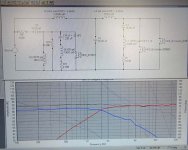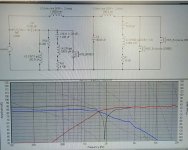Dear All,
Just recently I've been playing around with speaker workshop, Doing Xo simulation.
I made a 2way mtm design that produces a reasonably flat freq. response in the simulation. The woofer offset is -1.2 inch, using 7" woofer and a dome tweeter, It means that the baffle is flat.
I then reversed the polarity of the tweeter to see the Xo suckout, The notch is a good minus 50db more or less from the average response of the speaker, It's a good sign.
But...
The center of the notch is not at the center of XO freq. The center of the notch is at around 1880hz, but the Xo freq is at around 1580hz...
Is this ok ?
Does the notch need to be at the center of the XO freq?
If so , What can I adjust to move it to the center .
The XO is LR4 acoustic.
Thank you.
Just recently I've been playing around with speaker workshop, Doing Xo simulation.
I made a 2way mtm design that produces a reasonably flat freq. response in the simulation. The woofer offset is -1.2 inch, using 7" woofer and a dome tweeter, It means that the baffle is flat.
I then reversed the polarity of the tweeter to see the Xo suckout, The notch is a good minus 50db more or less from the average response of the speaker, It's a good sign.
But...
The center of the notch is not at the center of XO freq. The center of the notch is at around 1880hz, but the Xo freq is at around 1580hz...
Is this ok ?
Does the notch need to be at the center of the XO freq?
If so , What can I adjust to move it to the center .
The XO is LR4 acoustic.
Thank you.
What that tells you is you do not have phase tracking through the crossover. Turn on phase on both the woofer and tweeter in your crossover chart. The phase dotted lines for each driver should "line up" through the crossover region.
How did you generate phase for your drivers? Maybe if you can post an image here (with phase on) that would confirm things.
How did you generate phase for your drivers? Maybe if you can post an image here (with phase on) that would confirm things.
Hi,
This will always happen for for near LR4 acoustic with offsets, you need
to introduce some assymetry to get a null at the c/o point due to offsets.
2.5 way ? : http://www.diyaudio.com/forums/showthread.php?postid=1371987#post1371987
edit :also note that the null point will vary strongly with the vertical
axis and optimising it on-axis is not a particularly useful exercise.
The in-phase response over a range of vertical angles is much more
important and if the smoothest response has some phase mismatch
at the c/o point this is not as such a bad thing. Some topologies e.g.
subtractive crossovers require phase mismatching by definition.
 /sreten.
/sreten.
This will always happen for for near LR4 acoustic with offsets, you need
to introduce some assymetry to get a null at the c/o point due to offsets.
2.5 way ? : http://www.diyaudio.com/forums/showthread.php?postid=1371987#post1371987
edit :also note that the null point will vary strongly with the vertical
axis and optimising it on-axis is not a particularly useful exercise.
The in-phase response over a range of vertical angles is much more
important and if the smoothest response has some phase mismatch
at the c/o point this is not as such a bad thing. Some topologies e.g.
subtractive crossovers require phase mismatching by definition.
marchel said:
Hello Sreten,
So you're saying that the design is ok or acceptable?
Hi,
I'm saying that the vertical lobing and phase behaviour issues of an
MTM are somewhat different to a MT. For an MTM vertically up or
down the path difference between mid and treble becomes more
similar before at higher angles it begins increasing again.
(If you assume the more axial unit contributes more.)
I'm saying that for an MTM vertical lobing is one of the most important
issues and this may be optimum with some phase mismatch at the c/o
point. To accurately model this you need off axis responses of the
drivers noting that for a MTM on the tweeter axis at 1m the bass
units responses are not exactly the same as on the axis of the
bass unit.
According to your plot, the xover point is not at 1580 Hz but should be higher than that. Note that you have two midwoofer's combined response, as 2K pointed out, which has not been plotted in your graph. So nothing's wrong with your simulation.
And as others suggested, do not worry too much about perfect phase alignment. This design is basically LR4 and not too much sensitive to a bit of phase misalignment. Fine-tuning after build is more important to obtain good tonal balance for you.
And as others suggested, do not worry too much about perfect phase alignment. This design is basically LR4 and not too much sensitive to a bit of phase misalignment. Fine-tuning after build is more important to obtain good tonal balance for you.
sreten said:To accurately model this you need off axis responses of the
drivers noting that for a MTM on the tweeter axis at 1m the bass
units responses are not exactly the same as on the axis of the
bass unit.
/sreten.
True, sreten. But with this 7" woofer, as long as we use a relatively low xover point (lower than 2 kHz) and CTC distance between drivers is minimized, this crude simulation is not that far from reality. I checked this from many similar simulations and by comparing the results to actual measurements.
And we don't listen 1 m away unless they are nearfield monitors. 2m modeling is more realistic. In this case, off axis beaming of the midwoofer due to its vertical offset from the listening/mic axis is not that significant especially when the xover point is low.
2K said:For your simulations you are using the response of one woofer instead of the combined response of both to show the coss point. The null uses both woofers and is probably close to where it should be.
How come I never thought of that before ? Heheheh, There should be a 6 db increase in the woofer response and the xo point should rise. ( knock on the head).
Dave Bullet said:Did you check that you set the offset of BOTH woofers to -1.2"?
Yes I did, many times .

Many thanks to all who helped me solve the puzzle.
I'm just toying around with the idea of designing a 2 way MTM, I also have a 2.5 way simulation.
LINK But I'm not really sure though what type produce better sound, As both type of designs are commercially popular.
BTW , I already have the 2 tweeter , And the 4 woofer should arrive 6 days from now, Then I could start building.
Jay_WJ said:
True, sreten. But with this 7" woofer, as long as we use a relatively low xover point (lower than 2 kHz) and CTC distance between drivers is minimized, this crude simulation is not that far from reality. I checked this from many similar simulations and by comparing the results to actual measurements.
And we don't listen 1 m away unless they are nearfield monitors. 2m modeling is more realistic. In this case, off axis beaming of the midwoofer due to its vertical offset from the listening/mic axis is not that significant especially when the xover point is low.
Hi,
For the first point I was alluding to the fact that fine details cannot
be modelled / investigated without extensive data, as you say the
reality is that to use sims within sensible limitations an extensive
data set is not needed, I'd add also generally not available.
The other points are more general related to MTM's.
Understanding them is understanding why the low c/o point is a good idea.
Others may consider the design as a horizontal centre so vertical
off axis performance is of interest compared to other MTM's.
(MTM vs MT room drive for off axis reverberation is probably best
left to another discussion, though I favour the 2.5way approach ...)
tinitus said:.
..but how do know that your sims are what you actually achieve and hear...

Hi,
May I step in here ....... Maximising the probability of pure simulation
being correct does not guarantee correctness by definition. If you
get a dodgy driver, changed or mismatched units how would you
know ? You haven't measured them for response, distortion etc.
Zaph does make a big deal about measured consistency
Fortunately as long as you have a few references that do work, then
if things do go seriously pear shaped you should be able to hear it.
The one off builder is not so fortunate, and one off measurements
are also pretty useless as any accuracy cannot be confirmed.
When simulation data does agree with others test data there is
no sensible reason not to trust the simulations within the scope
of their predictable accuracy - this is a complex multidimensional
probability function - its a lot easier to use some common sense.
The sims do not tell the whole story and do not indicate completely
what has been achieved or the way speakers sound, they indicate
the ball park you are working in, given the input information.
The tuning by ear of a speaker is not that difficult if you know what
it is that you are changing, and at this point you do not care whether
the SIM is telling you it is less correct, SIMs have limitations .....
Jay_WJ said:
And we don't listen 1 m away unless they are nearfield monitors. 2m modeling is more realistic. In this case, off axis beaming of the midwoofer due to its vertical offset from the listening/mic axis is not that significant especially when the xover point is low.
I'm a firm believer in 2M measurements ( and 3M modeling ) of both the raw drivers on baffle and together with a crossover in place. It's more effort but the data is more acurate.
- Status
- This old topic is closed. If you want to reopen this topic, contact a moderator using the "Report Post" button.
- Home
- Loudspeakers
- Multi-Way
- Crossover suckout question.

